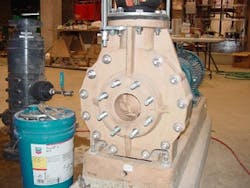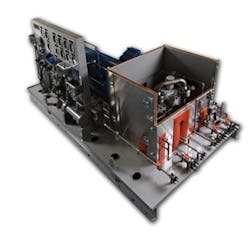Centrifugal pumps are common at many plants — Figure 1 shows a typical centrifugal pump and Figure 2 a complex multi-casing one for a high-pressure service. Unfortunately, plants often suffer unnecessary pump downtime. Operating conditions not mentioned in the pump order document and not considered in pump design and manufacturing account for more than 75% of all unscheduled shutdowns. Alternative operating points and transient operating conditions are particular culprits. So, it's important to accurately indicate flow rates, required heads, liquid details and net positive suction head (NPSH) available for all possible operating scenarios for a pump.
Figure 1. Many plants contain a large number of such pumps.
In a poor pump selection, the specified rated point is located either in the overload region — which can indicate too small a pump has been chosen — or relatively near the shutoff point. The rated operating point should be close to the best efficiency point (BEP). It's usually difficult to give a general guideline because the limits depend upon the pump details, the pump curve and the application. However, as a rough rule, the rated capacity preferably should fall in the range of 65% to 112% of the BEP flow. The overload region generally poses more concern as far as potential under-sizing of the pump — 112% is a firm limit. In some situations, 55% of the BEP flow may be acceptable. Most damage and reliability issues, especially with bearings, seals and the like, stem from pump operation at point(s) relatively far from the BEP point.Figure 2. This complex pump has its own enclosure. Source: Sundyne.
A flat pump curve can cause operational problems. A pump with a flat curve can experience rapid flow changes/fluctuations and instability as a result of a small head change downstream. Any pump should have a minimum 8% rise from the rated point to the shutoff head. Some process pumps, including critical ones, should have a 12% minimum head rise to the shutoff. High-pressure, high-speed and integrally geared pumps each usually have relatively flat curves. So, their selection demands special care.Avoid double suction pumps. They usually provide poor reliability and performance and prompt many operational problems.STANDARDSBoth the American National Standards Institute (ANSI) and the American Petroleum Institute (API) provide pump standards. Pumps meeting the ANSI standard often are chosen for less-demanding chemical and utility services. The API-610 standard is more stringent — and usually is considered the minimum specification for pumps that handle hazardous, flammable, toxic and explosive liquids because any reliability issue or even a small incident in the pump could result in a disaster. API-610 pumps also are very popular in extreme temperature services (even in some critical water services such as boiler feed-water pumps) or low temperature applications. In some cases, firewater and critical cooling pumps are specified to comply with the API-610 to achieve high reliability.ANSI and API pumps differ in some important ways. For example, horizontal ANSI pumps usually are foot-mounted while horizontal API pumps often are centerline-mounted. The thermal expansion/contraction of the shaft centerline of a foot-mounted horizontal ANSI pump can be two-to-three times greater than that of a comparable centerline-mounted horizontal API pump. This could directly affect pump train alignment and pump reliability.API-610 pumps are superior for process liquids, hydrocarbons, petrochemicals, extreme temperature services and critical applications. There's always some discussion about whether or not to use the API-610 standard for a service. The decision should depend upon the application (the liquid, the plant, etc.), the pump head, the service temperature, the power rating, the capacity, the pump speed and the expected reliability. The main variable is the service (the liquid, the plant and the desired reliability). For a differential pressure of more than 20 bar, API-610 usually is specified, even for some critical water and utility services. When the pumped liquid temperature exceeds 140oC or is very low, API-610 always is preferred. Using the pump power rating to decide whether to use API-610 is a bit tricky because there are many non-API and manufacturer-standard pumps available with successful references for high power ranges in wide variety of services. For process pumps, consider API-610 for applications above 400 kW. (For some services, this limit could drop to 100 kW.) Non-API high-speed pumps usually aren't popular. For a service requiring a pump speed above 4,000 rpm, an API pump could be a good option. Use a between-bearing pump design when size, power rating and power density exceed a certain level. As a rough indication, this limit could be >450 kW for a high-speed pump but could be lower, e.g., >200 kW, for some critical service pumps. FACTORS IN RELIABILITYLubrication and sealing systems should play an important role in pump selection, design, manufacturing and purchase because they significantly affect pump operation and reliability. Often, repairing a pump doesn't solve the underlying problem and the failure recurs. In these cases, a truly effective solution requires correct root-cause analysis — this demands sufficient knowledge of the lubrication and sealing systems. Lubrication. Oil bath lubrication may suffice for a small pump but can't be used if frictional heat generation is relatively high. It isn't suitable when the shaft size or speed of the pump exceed certain levels. As a very rough guide, don't consider oil bath lubrication for shaft diameters exceeding 1.5 in. (40 mm) or speeds over 3,000 rpm. If the oil level reaches the center of the bearing, a considerable amount of heat could be generated. So, set the oil level below the center of the bearings. When the linear speed in the bearings increases beyond a certain point, oil bath lubrication and oil rings become unsuitable and unreliable. The oil rings in particular often cause problems. For pump designs above a certain size or beyond a certain speed, an additional device to lift and spray the oil into the bearings is worthwhile. Today, cartridge-mounted bearings with flinger devices (to lift and spray oil into the bearings) are popular for pumps. Oil-mist (oil-fog) lubrication systems are gaining favor for small-size and some medium-size rotating machines using rolling element bearings. Sealing system. Very few new pumps still use packing. Pumps instead rely on mechanical seals. In these, the seal faces are separated by a small gap into which a clean, cool flushing fluid is injected. This fluid not only prevents contact between the faces but also cools them. Use of a flushing fluid requires a number of connections, including ones for fluid inlet and outlet (both usually at the top of the pump), a vent (to remove vapor or gas from the seal cavity) and a leakage monitoring port. When ambient air must be prevented from penetrating the space between the seal faces or greater cooling, safety or reliability is required, pumps can be equipped with a dual seal; it has a secondary seal in addition to the primary one. In this design, a secondary fluid, known as the "barrier" or "buffer" fluid, is injected into the gap between the primary mechanical seal and the secondary one.Pumps, e.g., for general applications and clean liquids, often use a "Plan 11" seal system in which a liquid side stream is recirculated. This side stream should have a pressure around 1.5–2 bar higher than that directly behind the pump impeller where the mechanical seal is located. Usually an orifice also is located in the flushing liquid route. Clogging of seal piping or the seal orifice reportedly is a common issue. A "Plan 23" seal system includes a heat exchanger. It offers better thermal management of the flushing liquid and, thus, enhanced seal reliability and performance. This plan is popular for pumps in hot services or handling liquids working near their vaporization point. It can improve the vapor pressure margins in the seal chamber. Today, the "Plan 23" is very popular for hot water services, especially boiler feed-water pumps. The performance of the heat exchanger, which usually is cooled by cooling water, requires careful monitoring in all services. Operators have avoided the "Plan 23" for a number of reasons, including its greater complexity. However, modern "Plan 23" cartridge-type mechanical seals easily can be used in a wide range of pump applications.Dual seals using a secondary fluid need a special seal support system. "Plan 32" often has been used for these applications but now "Plan 53A" is more popular; in many pumps, the "Plan 32" has been converted to the "Plan 53A." Dual seals and "Plan 53A" are employed for harmful or hazardous services. This arrangement also is chosen for liquids that contain suspended solids or that have poor lubricity. Dual seals commonly are specified for services that can't tolerate even a small leakage to the atmosphere.
AMIN ALMASI is a rotating equipment consultant based in Brisbane, Australia. E-mail him at [email protected]





